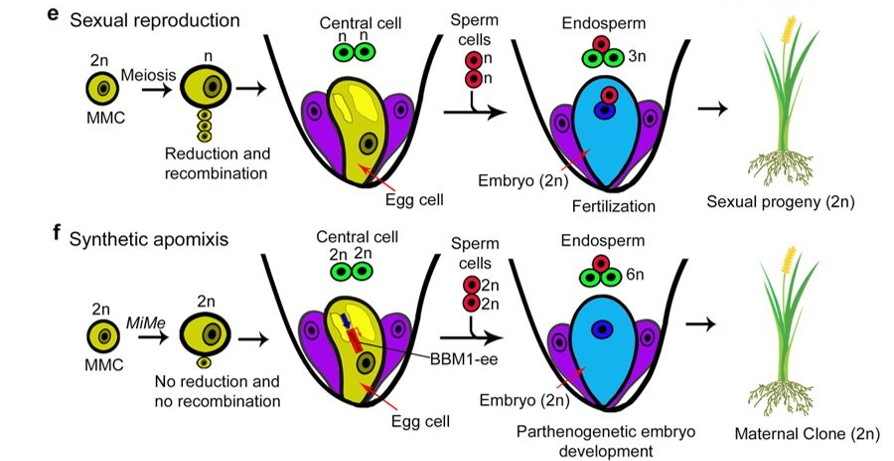Apomixis is a mode of seed formation by asexual means. It occurs in plants that possess the ability to bypass the most fundamental parts of sexual reproduction namely, meiosis and fertilization. In the absence of meiosis and fertilization, the resulting seed germinates into a plant that purely develops as a maternal clone.
This article will help you understand the main concepts of apomixis and the various aspects of it.

Index
What is Apomixis
It is the process in flowering plants that results in the formation of a seed from the maternal tissues of the ovule, by asexual methods leading to embryo development. The current usage is synonymous with the term “agamospermous”, termed by Richards (1997).
As seed formation is a characteristic feature of angiosperms and gymnosperms of the plant kingdom, apomixis is strictly found in these groups.
Characteristics
The characteristics of Apomixis are:
- It is an asexual mode of reproduction in plants having seed-habit.
- It occurs without the fusion of the male and the female gamete, and as a result, there is no genetic recombination. This suggests that seeds generated through apomixis do not show variation in the population.
- It facilitates the rapid development of pure lines and therefore is used as a tool in agriculture.
- Seed production can be achieved by haploid parthenogenesis.
- It can be genetically controlled.
- It is extremely useful in the conservation of superior genotypes and maintaining hybrid vigor.
Types of Apomixis
It can be brought about in various ways. So, it can be classified as:
- Parthenogenesis: The embryo development occurs from the ovum or the egg cell.
- Apogamy Apomixis: The embryo development occurs from the synergids or antipodal cells. It may be haploid or diploid.
- Diplospory: The unreduced embryo sac develops from a megaspore mother cell by the abortion of meiotic divisions or a mitotic division.
- Apospory: The nuclear cells that give rise to Apomictic embryo sacs develop from the nuclear cells known as aposporos initials, hence the name Apospory. These undergo differentiation in close proximity to the ameiotic megasporocyte and develop into an apomictic embryo sac.
- Adventive Embryony: This type of apomixis is known as sporophytic apomixis. In this type of apomixis, the embryos do not rise from the cells of the gametophyte instead they develop from the nuclear cells.
- Recurrent Apomixis: It is also known as gametophytic apomixis. The megagametophyte possesses the exact number of chromosomes as the mother plant. This happens due to the occurrence of incomplete meiosis.
- Non-Recurrent Apomixis: The embryo sac consists of haploid cells and the embryo develops from a haploid cell.
How does Apomixis Take Place
Unlike the process of seed formation by sexual means, apomixis can take place by various mechanisms that share three common developmental components:
- A diversion of meiotic cell division during the formation of embryo sac known as apomeiosis
- By parthenogenesis where the embryo develops without any event of fertilization.
- Formation of viable endosperm either via fertilization-independent means or following fertilization with a sperm cell. The progeny derived from apomictic development are clonal and therefore genetically identical to the maternal parent.
FAQs
Amphimixis is a mode of sexual reproduction, where the fusion of two gametes takes place whereas apomixis is a mode of asexual reproduction, which occurs without the event of fertilization.
Apomixis and parthenocarpy are both asexual modes of reproduction. The difference is that apomixis gives rise to seed formation, whereas parthenocarpy gives rise to the formation of fruits.
